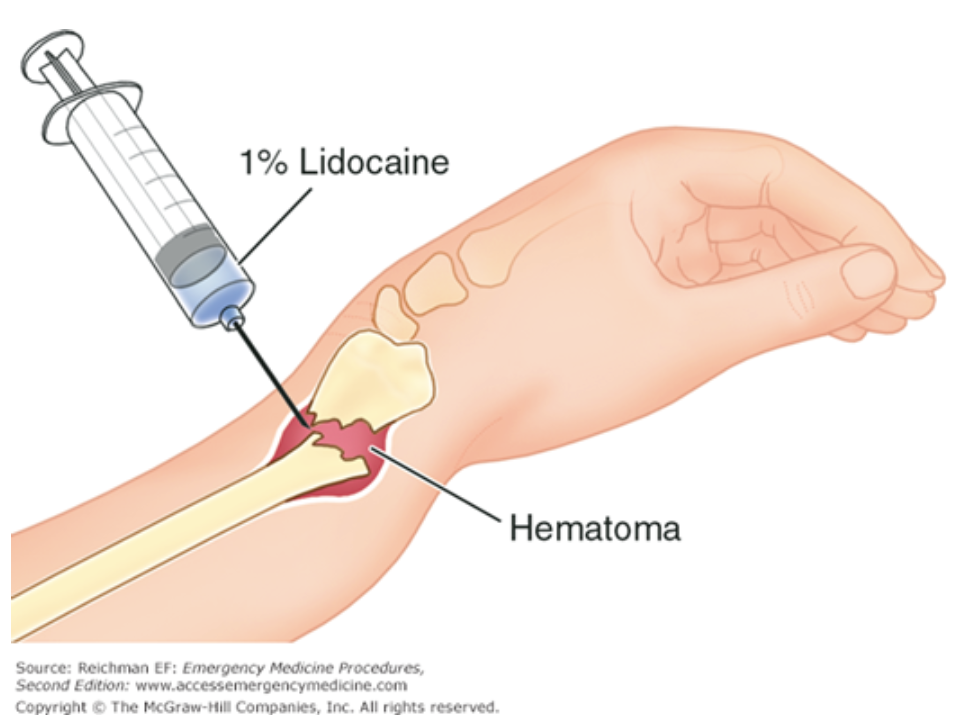Hematoma Blocks
Written by: Tina Yang, DO; Edited by: Tim Khowong, MD
Introduction:
Distal extremity fractures are frequently seen in the Emergency Department. These fractures often require closed reduction by manipulation, which can be a painful and unpleasant experience for the patient. Achieving sufficient analgesia is vital to reduction and to minimize patient discomfort. Conscious sedation is a frequently used method, however it has its associated risks and is a time consuming process. The hematoma block is a technique to inject a local anesthetic into the hematoma between the fractured bone fragments. The hematoma encompassess osteal, periosteal, and neural structures surrounding the fracture, which are the source of the pain. Thus, it follows that directly injecting anesthetic into the hematoma will provide analgesia for a painful fracture. The hematoma block, unlike procedural sedation, avoids the side effects of sedating drugs, does not require intravenous access and cardiac monitoring, and is not associated with a prolonged recovery phase. Fracture manipulation can then be performed painlessly or with significantly reduced pain. Hematoma blocks of the distal forearm are considered safe in both pediatric and adult patients. The majority of important neurovascular structures in the upper extremity are contained in the volar soft tissue, making the dorsal or lateral approach preferred. The majority of important neurovascular structures in the lower extremity are contained in the proximal anterior thigh or posteriorly in the leg, making the lateral approach preferred in the proximal thigh and the anterior or lateral approach from the mid-thigh distally.
Contraindications:
Absolute:
Allergies to local anesthetic agents
Open fracture
Overlying cellulitis
Presence of a neurovascular deficit
Uncooperative patient
Relative:
Bleeding Disorders
Anticoagulation use
Supplies:
Sterile or non-sterile gloves
Cleansing solution (iodine, chlorhexidine solution, or alcohol wipes)
12 cc syringe
Large bore needle to draw medications (blunt tip or 18-22 gauge)
Large bore needle for injection (18-22 gauge)
Small bore needle for wheal (25 gauge)
8-12 cc 1 or 2% lidocaine
Steps:
After obtaining x-rays to confirm a fracture and providing the patient analgesia in the form of ice packs and oral pain relievers, identify the fracture sign over the dorsal aspect of the forearm
Position extremity on hard surface
Identify and mark your injection site by palpating for the step off of the fracture.
Use a 25 gauge needle to create a 1cc wheal of lidocaine at the skin surface to anesthetize the skin.
Disinfect the skin with an antiseptic solution such as betadine or chloraprep.
Insert an 18 gauge needle through the skin wheal into the hematoma until bone is encountered - confirm correct placement by aspirating blood.
Inject 5 to 15 mLs of 1% lidocaine into the fracture cavity and around the surrounding periosteum. You may also inject 5 to 10 mLs of 2% lidocaine.
Remove needle, apply pressure with gauze
Dress site, proceed with reduction(s) only after 5-10 minutes when block is fully in effect
Pearls:
Can use a combination of lidocaine and bupivicaine for rapid onset and longer acting analgesia/anesthesia
Can use C-arm to guide the needle to the fracture site to increase the chance of successful block in distal radius fractures
If it has been several hours since injury, hematoma may have already started to organize and be unaspiratable
Ultrasound-guidance may improve success
Video:
References:
http://brownemblog.com/blogposts/2021/4/22/hematoma-block-of-the-wrist
https://wikem.org/wiki/Hematoma_block
https://accessemergencymedicine.mhmedical.com/content.aspx?bookid=683§ionid=45343769#57713163
https://epmonthly.com/article/hematoma-blocks-for-reduction-of-distal-radius-fractures/

